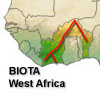 



Weather data
A large number of automatic weather stations has been implemented in the frame of the BIOTA AFRICA project by the Namibian National Botanical Research Institute (NBRI) and the Group "Biodiversity, Evolution and Ecology" (BEE) of the University of Hamburg. The website offers hourly updates of data and graphs of a large number of weather parameters.

|
 BIOTA West Africa - Workpackage - CT2-T2-WP1
BIOTA West Africa - Workpackage - CT2-T2-WP1
Core Topic (CT) |
Land use changes: agriculture and restoration |
Topic (T) |
Sustainable use of selected organisms |
Title |
 Fish, fisheries and aquaculture: sustainable ways to use natural fish resources and feasible alternatives
Fish, fisheries and aquaculture: sustainable ways to use natural fish resources and feasible alternatives
|
Project leader(s) |
Prof. Dr. K. Eduard Linsenmair
Melanie Hauber
|
Project description |
Freshwater fish are an important food resource for inhabitants in the sub-Saharan region. In Africa 40 % of domestic catches come from inland fisheries (FAO 1996). The productivity of African freshwater ecosystems is high, however unsustainable fishing is damaging the stocks resulting in much smaller catches than the estimated potential yields.
This workpackage therefore has two major tasks:
- It investigates fish communities in regions with differing degrees of human impact (Pendjari region) in order to quantify the effects of these impacts for different fish species in detail. To proceed from data sampling to application we develop management plans taking into account the needs of the local population on the one hand while determining the limits of use on the other hand to ensure the conservation of the fishs diversity and the long term potential for a sustainable harvest. Monitoring systems are developed, as common monitoring procedures using gill nets have a high negative impact, and are therefore not recommendable in systems requiring a minimum degree of disturbance, such as national parks. Thus, we will apply two other methods:
- Monitoring of small fish species using small seines.
- Monitoring of Mormyrids. The unique character of electric organ discharges (EOD) in the Mormyridae could allow the development of a fish community monitoring system with almost no disturbance during data sampling.
- As the capture of fisheries becomes stagnant or decreases, a crucial role for lowering the pressure on natural fish stocks in forthcoming decades has to be played by farming of fish and other aquatic organisms in aquaculture facilities. We therefore focus on two main problems of this issue:
- finding solutions of supplementary feeding for the farmed organisms
- developing adapted farming methods of hitherto not yet used new and most promising native species on the basis of our knowledge on their biology/ecology.
|
|
|






 Go to the WeatherNet
Go to the WeatherNet BIOTA West Africa - Workpackage - CT2-T2-WP1
BIOTA West Africa - Workpackage - CT2-T2-WP1 Fish, fisheries and aquaculture: sustainable ways to use natural fish resources and feasible alternatives
Fish, fisheries and aquaculture: sustainable ways to use natural fish resources and feasible alternatives